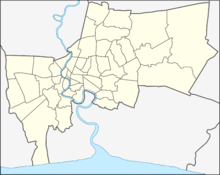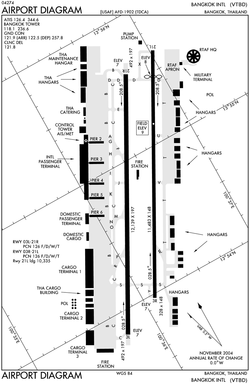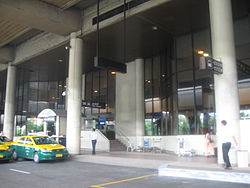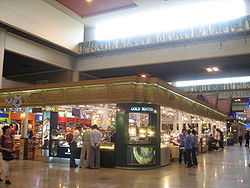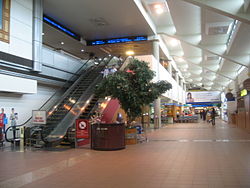- Don Mueang International Airport
-
Don Mueang International Airport
ท่าอากาศยานนานาชาติดอนเมืองIATA: DMK – ICAO: VTBD Summary Airport type Public/Military Operator Airports of Thailand Location Bangkok, Thailand Hub for Elevation AMSL 9 ft / 3 m Coordinates 13°54′45″N 100°36′24″E / 13.9125°N 100.60667°ECoordinates: 13°54′45″N 100°36′24″E / 13.9125°N 100.60667°E Map Location within Bangkok Runways Direction Length Surface ft m 03L/21R 12,139 3,700 Asphalt 03R/21L 11,482 3,500 Asphalt - For the military use of the facility see Don Muang Royal Thai Air Force Base
Don Mueang International Airport (Thai pronunciation: [dɔ̄ːn mɯ̄aŋ]) (IATA: DMK, ICAO: VTBD) is an airport in Bangkok, Thailand. It was officially opened as a Royal Thai Air Force base on 27 March 1914, although it had been in use earlier. Commercial flights started in 1924. Don Mueang Airport closed in 2006 following the opening of Bangkok's new Suvarnabhumi Airport, before opening again after the big renovation on 24 March 2007.
Don Mueang was an important hub of Asia and the hub of Thai Airways International prior to its closure. At its peak, it served most air traffic in the whole continent, with 80 airlines operating 160,000 flights and handling over 38,000,000 passengers and 700,000 tons of cargo in 2005. It was then the 18th busiest airport in the world and 2nd in Asia by passenger volume. Currently, the airport is Thailand's fourth busiest airport by passenger traffic, with 3 million passengers passing through it in 2010.
Don Mueang became a facility for charter flights, military aircraft and civil aviation. The airport was reopened for non-connecting domestic commercial flights on 24 March 2007. Two airlines are now using the airport: Nok Air and Orient Thai Airlines (formerly One-Two-GO Airlines). All Thai Airways domestic flights were transferred to Suvarnabhumi Airport.
Don Mueang is a joint-use facility with the Royal Thai Air Force's Don Muang Royal Thai Air Force Base, and is the home of the RTAF 1st Air Division, which consists primarily of non-combat aircraft. Vibhavadi Rangsit Road is the main route linking the airport with downtown Bangkok. The Uttaraphimuk Elevated Tollway, running above Vibhavadi Rangsit, offers a more rapid option for getting into the city and connects to Bangkok's inner city expressway network. There is also rail service connecting with Hua Lamphong station in the center of Bangkok. The train station is across the highway and is linked with the airport by a walkway bridge. An RTAF golf course is located between the two runways. The course has no separation from the runway, and golfers are held back by a red light whenever planes land.
Contents
History
Don Mueang airfield was the second established in Thailand, after Sa Pathum, which is now Sa Pathum horse racing course. The first flights to Don Mueang were made on March 8, 1914 and involved the transfer of aircraft of the Royal Thai Air Force. Three years earlier, Thailand had sent three army officers to France to train as pilots. On completion of their training in 1911, the pilots were authorized to purchase four Breguets and four Nieuports, which formed the basis of the Royal Thai Air Force.
In 1933, the airfield was the scene of heavy fighting between royalists and government forces during the Boworadet Rebellion.
Commercial service to Don Mueang began in 1924. The first commercial flight was an arrival by KLM.
The airfield was used by the occupying Japanese during World War II, and was bombed and strafed by Allied aircraft on several occasions.
During the Vietnam War, Don Muang was a major command and logistics hub of the United States Air Force.
Before the opening of Suvarnabhumi, the airport used the IATA airport code BKK and the name was spelled Don Muang. After Suvarnabhumi opened for commercial flights, the spelling was changed and as Don Mueang it now uses the airport code DMK, though it still retains the ICAO airport code VTBD.
Accidents and incidents
- 14 June 1972 – Japan Airlines Flight 471, which originated at Don Mueang, crashed outside of New Delhi's Palam International Airport, killing 82 of 87 occupants; 10 of 11 crew members and 72 of 76 passengers died, and 3 people on the ground died.[1] 16 of the dead were Americans.[2]
- 25 December 1976 – EgyptAir Flight 864, a Boeing 707-300 bound for Bangkok from Cairo, crashed into an industrial area near the airport during a landing attempt. All 53 aboard were killed.
- 27 April 1980 – a Thai Airways BAe 748 en route from Khon Kaen to Bangkok lost altitude during a thunderstorm and crashed about 8 miles (13 km) from Bangkok International Airport. All four crew members and 40 of the 49 passengers were killed.
- 1981: The Hijacking of Flight Garuda Indonesia GA 206 on 28 March 1981. This was the first serious Indonesian airline hijacking, since the first was a desperate Marine hijacker who was killed by the pilot himself. The hijackers, a group called Commando Jihad, hijacked the DC 9 "Woyla", enroute from Palembang to Medan, and ordered the pilot to fly the plane to Colombo, Sri Lanka. As the plane didn't have enough fuel to reach Colombo, it refueled in Penang, Malaysia and then flew to Don Mueang. The hijackers demanded the release of Commando Jihad members imprisoned in Indonesia, and US$1.5 million, as well as another plane to take the released prisoners to an unspecified destination. The then Kopasandha commandos (now Kopassus), led by Lieutenant Colonel Sintong Panjaitan and directly supervised by Lieutenant General Benny Moerdani as the head of the Armed Forces Intelligence, who took part in this mission, trained only three days with totally unfamiliar weapons, brilliantly executed this fast-paced operation. One of the Kopasandha commandos was shot by the hijacker leader, who then shot himself. The airliner's pilot, Captain Herman Rante, was shot dead, probably by a stray bullet. The other hijackers were killed and the hostages rescued.
- 29 November 1987 – Korean Air Flight 858, flying from Baghdad International Airport in Baghdad, Iraq to Abu Dhabi International Airport in Abu Dhabi, United Arab Emirates to Don Mueang to Gimpo Airport near Seoul, South Korea, exploded over the Andaman Sea after a bomb planted by North Korean agents exploded. Everyone on board died.
- 26 May 1991 – Lauda Air Flight 004, which was headed to Wien-Schwechat International Airport in Vienna, suffered an in-flight deployment of the thrust reverser on the No. 1 engine after taking off from Don Mueang. There were no survivors from the 213 passengers and 10 crew.
- 21 January 1992 - Douglas VC-47D L2-41/15/210 of the Royal Thai Air Force was damaged beyond repair in a landing accident.[3]
- If Project Bojinka had not been discovered after a fire in Manila, one or more aircraft owned by U.S. carriers flying to Bangkok would have blown up over the Pacific Ocean on January 21, 1995 as part of the project's first phase.
- 22 August 1999 – China Airlines Flight 642, which was landing in Tropical Storm Sam at Hong Kong International Airport in Hong Kong on a route from Don Mueang to Hong Kong, rolled upside down on the runway. The plane came to rest upside down. 3 of the passengers died.
- 23 September 1999 – Qantas Flight 1, in what was then the most serious incident in the airline's famously safe jet aircraft history, saw a Boeing 747-400 overshoot the runway causing significant damage, but no casualties.
- 3 March 2001 – Thai Airways International Flight 114, a Thai Airways International Boeing 737-400 (HS-TDC), bound for Chiang Mai from Bangkok, was destroyed by an explosion and fire that occurred about 35 minutes before the Former Prime Minister Thaksin Shinawatra and about 150 other passengers were to board. Five members of the cabin crew were aboard, and one was killed. Witnesses said they heard an explosion before flames erupted aboard the aircraft. NTSB investigators reported that the center fuel tank exploded followed by the right tank 18 minutes later. The cause for the explosion was unclear; however, no traces of explosive were found. The center fuel tank is located near air conditioning packs, which generate heat and were running nonstop prior to the explosion.
- 16 September 2007 – One-Two-GO Airlines Flight 269, a McDonnell Douglas MD-82 (HS-OMG), on a short routine flight from Don-Muang airport, Bangkok to Phuket International Airport the aircraft overran the runway in wild weather consisting of battering shower storms. Of 123 people on board, 88 were said to have been killed.
Last flights before the move to Suvarnabhumi
The night of September 27–28, 2006 was the official end of operations at Don Mueang airport. The last commercial flights were:
- Domestic departure: Thai Airways TG 124 to Chiang Mai at 22:15 (coincidentally, when Thai moved domestic operations back to Suvarnabhumi again on 28 March 2009, their last departure was also a 22:15 flight to Chiang Mai)
- International arrival: Kuwait Airways from Jakarta at 01:30[4]
- Domestic arrival: TG 216 from Phuket at 23:00
- International departure: Although scheduled for Kuwait Airways KU 414 to Kuwait at 02:50,[5] Qantas flight QF302 to Sydney, originally scheduled for 18:00, was delayed for more than 9 hours before finally taking off at 03:12, about 10 minutes after the Kuwait flight. Qantas claimed that QF302 was an extra flight.[6]
Nevertheless, Don Mueang continues to be used for charter flights as well as the domestic carriers despite the fact the higher landing fees of the new airport are now being applied to Don Mueang as well.
Reopening the airport
Although initially deserted by commercial carriers upon the opening of the Suvarnabhumi Airport, the higher costs of the new airport to operators as well as safety concerns over cracked runways at the new airport caused many to seek a return to Don Mueang. In particular, low-cost airlines have led demands for reopening of the airport. Airports of Thailand released a report at the end of 2006 which furthered this effort, proposing it as a way to avoid or delay second-stage expansion which had been planned for Suvarnbhumi.[7]
On 30 January 2007, the Ministry of Transport recommended temporarily reopening Don Mueang while touch up work process on some taxiways at Suvarnabhumi proceeds. The recommendation was subject to approval by the government's executive Cabinet. On March 25, 2007, the airport officially reopened for some domestic flights.
Closure due to flooding
Because of the recent flooding that is affecting Bangkok and the rest of Thailand, the airport has closed as flood waters flowed on to the runways and affected the lighting. [8][9]
Flights
Don Mueang International Airport has 3 terminals. Terminal 1 and Terminal 2, used as the international terminals before the opening of Suvarnabhumi Airport, are currently not used, while Terminal 3 is in active use as a domestic terminal. All flights will relocate to Terminal 1 on 1 August 2011.[10]
Airlines and destinations
Airlines Destinations Nok Air Buriram, Chiang Mai, Hat Yai, Nakhon Si Thammarat, Nakhon Phanom, Narathiwat , Phitsanulok, Phuket, Sakhon Nakhon, Surat Thani, Trang, Ubon Ratchathani, Udon Thani Nok Mini operated by Siam General Aviation Loei, Mae Sot, Nakhon Phanom, Nan, Phrae, Roi Et, Sakhon Nakhon Orient Thai Airlines Chiang Mai, Chiang Rai, Hat Yai, Nakhorn Si Thammarat, Phuket, Trang, Udon Thani Solar Air Chumphon, Loei, Mae Sot, Phare, Roi Et, Hua Hin, U-Tapao See also
References
1. ^ Bangkok Post, All flights must use new airport from September 28, June 19, 2006
2. ^ Flight International, [2] The airport is presently using the IATA airport code DMK, while Suvarnabhumi Airport has inherited its previous code BKK. Flyer Talk,[3], August 26, 2006.- ^ "14 JUN 1972 Douglas DC-8-53 Japan Air Lines – JAL." Aviation Safety Network. Retrieved on March 23, 2009.
- ^ "Death Toll in Air Disasters Heavy." United Press International via Oshkosh Daily Northwestern. Thursday June 15, 1972. Retrieved on March 23, 2009.
- ^ "L2-41/15/210 Accident description". Aviation Safety Network. http://aviation-safety.net/database/record.php?id=19920121-0. Retrieved 24 June 2010.
- ^ ATW: LH Cargo set to be first into Suvarnabhumi
- ^ Exporters pan new export fees
- ^ "Qantas steals show at last minute", Bangkok Post, 29 Sep 2006
- ^ "In With the Old", Aviation Week & Space Technology, January 1, 2007.
- ^ [1]
- ^ BBC News - Thai floods: Bangkok Don Muang airport suspends flights
- ^ http://www.bangkokpost.com/lifestyle/family/248663/don-muang-moves-local-flights-to-terminal-1
External links
- Don Mueang International Airport Homepage (English) (Thai)
- Google Aerial Photo
- Airport data
- News video of the last two flights from Don Mueang, as telecast on MCOT
- Airport information for VTBD at World Aero Data. Data current as of October 2006.
 Airports in Thailand
Airports in ThailandBangkok Don Mueang (DMK) · Suvarnabhumi (BKK)Central EasternNorthern Northeastern Southern Categories:- Buildings and structures in Bangkok
- Airports in Thailand
- Transport in Bangkok
- Airports established in 1914
Wikimedia Foundation. 2010.
Look at other dictionaries:
Don Muang International Airport — ท่าอากาศยานดอนเมือง (Don Mueang International Airport Bangkok) … Deutsch Wikipedia
Don Mueang District — Don Mueang ดอนเมือง Khet Khet location in Bangkok … Wikipedia
Don Mueang — Infobox Amphoe name=Don Mueang province=Bangkok thai=ดอนเมือง capital=Si Kan coordinates=coord|13|54|49|N|100|35|23|E|region:TH type:adm2nd population=157,989 population as of=2004 area=36.803 density=4,293 postal code=10210 geocode=1036 : This… … Wikipedia
Hong Kong International Airport — HKIA redirects here. HKIA may also refer to Hong Kong Institute of Architects. Hong Kong Airport redirects here. For the old airport at Kai Tak, see Kai Tak Airport. Hong Kong International Airport Chek Lap Kok Airport 香港國際機場 赤鱲角機場 … Wikipedia
Flughafen Bangkok-Don Mueang — Don Mueang International Airport Bangkok ท่าอากาศยานดอนเมือง … Deutsch Wikipedia
Bangkok International Airport — Suvarnabhumi International Airport … Deutsch Wikipedia
Suvarnabhumi International Airport — Suvarnabhumi International Airport … Deutsch Wikipedia
Don Mueang — ดอนเมือง Daten Provinz: Bangkok Fläche: 36,803 km² Einwohner: 159.003 (2005) Bev.dichte: 4320 E./km² PLZ: 10210 … Deutsch Wikipedia
Gimpo International Airport — Infobox Airport name = Gimpo International Airport nativename = nativename a = 김포국제공항 金浦國際空港 nativename r = Gimpo Gukje Gonghang Kimp o Kukche Konghang image width = caption = IATA = GMP ICAO = RKSS type = Public owner = operator = Korea Airports … Wikipedia
Bangkok International Airport — may refer to one of two airports serving serving Bangkok, Thailand:*Suvarnabhumi Airport, also known as the New Bangkok International Airport *Don Mueang International Airport, also known as the Old Bangkok International Airport … Wikipedia


